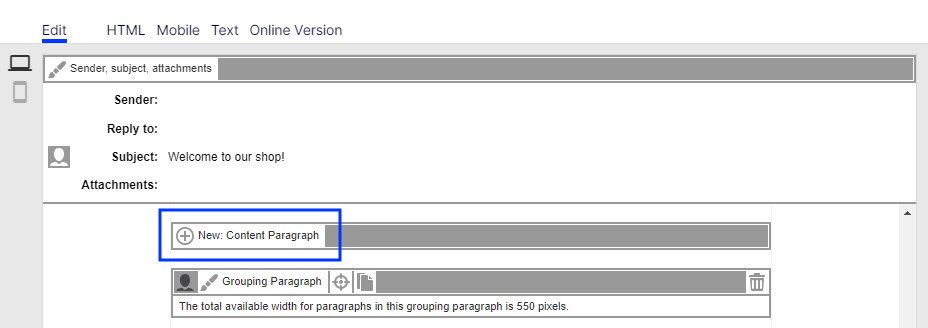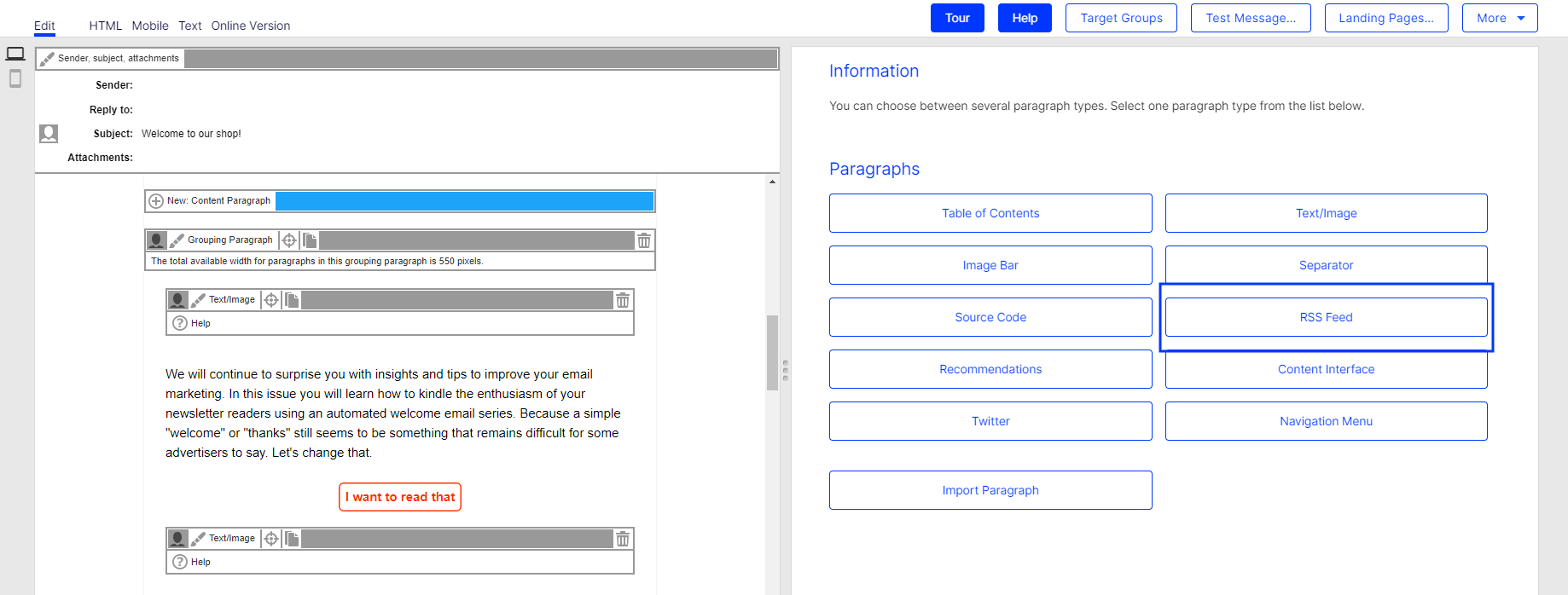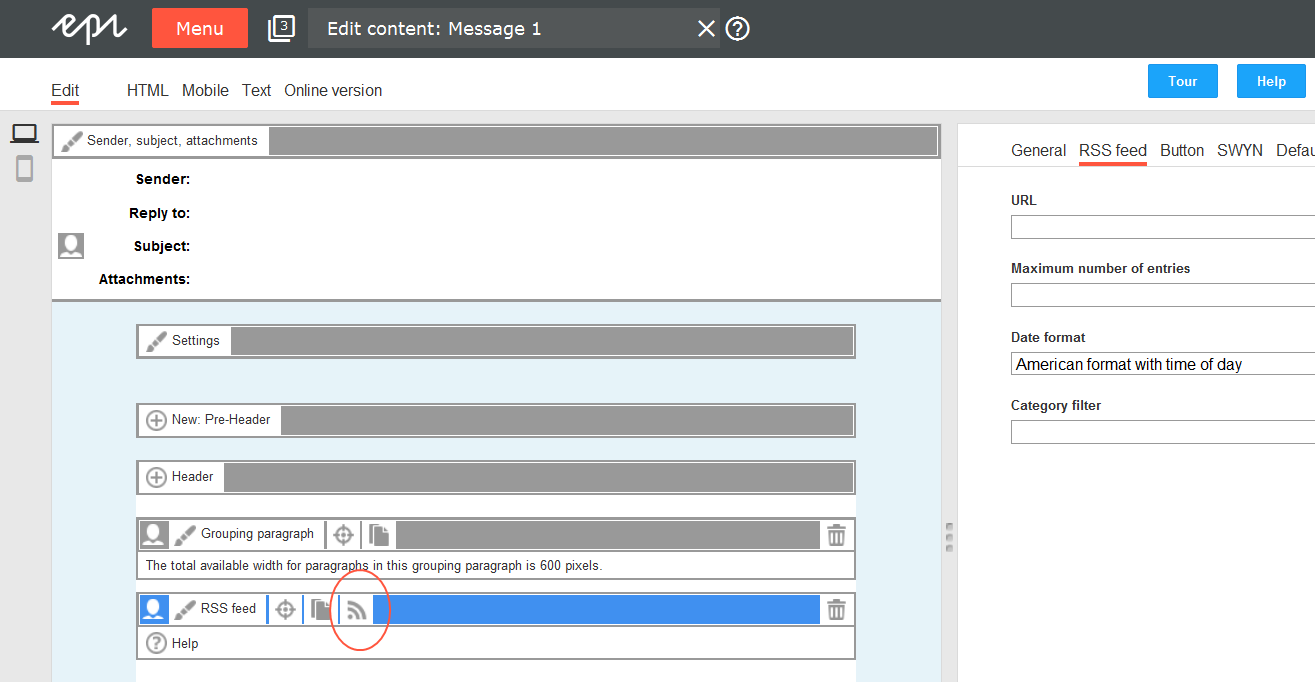 RSS feed paragraph
RSS feed paragraph
To enable this feature, contact customer support.
You can use an RSS Stands for "RDF Site Summary", also known as Really Simple Syndication, is a standard for distributing information from one website to another. Often used for distributing news feeds. feed to publish information in a standardized format, effectively providing a type of interface for third-party providers. The Template Kit can access this interface and incorporate its content into a newsletter. You can edit texts or reposition content after it is retrieved.
The Template Kit may contain several RSS feed paragraphs, each of which accesses a different feed.
You can insert RSS feed paragraphs into header and footer spaces and in structural paragraphs. Also, a supplementary tab is activated in the Template Kit's general settings, where you can set content order in default layout. You can define alternative layouts by entering HTML/text via the Options tab.
Formatting the RSS feed
For the RSS feed to be processed correctly, it must meet the RSS 2.0 specification. The required information for the channel node is not processed by the Template Kit, but it must still be available. Only the subnodes of the item node are used.
Optimizely Campaign only supports JPEG images in RSS feeds.
<?xml version="1.0"?>
<rss version="2.0">
<channel>
<title>RSS Feed</title>
<link>http://www.example.com/</link>
<description>Text</description>
<item>
<title>Title 1</title>
<description>Text</description>
<enclosure url="http://www.example.com/image1.jpeg" length="12345" type="image/jpeg" />
<link>http://www.example.com/title1</link>
<comments>http://www.example.com/title1/comments</comments>
<category>News</category>
<author>[email protected]</author>
<pubDate>Sun, 19 May 2002 15:21:36 GMT</pubDate>
</item>
<item>
<title>Title 2</title>
<description>Text</description>
<enclosure url="http://www.example.com/image2.jpeg" length="23456" type="image/jpeg" />
<link>http://www.example.com/title2</link>
<comments>http://www.example.com/title2/comments</comments>
<category>News</category>
<author>[email protected]</author>
<pubDate>Sun, 19 May 2002 15:21:36 GMT</pubDate>
</item>
</channel>
</rss> Creating an RSS feed paragraph
- While editing the mailing content in the Template Kit, click New: Content Paragraph.
You can also use the paragraph in the header and footer area by clicking Header or Footer.

- Click RSS Feed.

- In the configuration window, change no settings and click Apply. The new RSS feed paragraph appears on the left in the preview window.
Configuring an RSS feed paragraph
- On the left side of the preview, in the menu bar of the RSS feed paragraph, click RSS Feed.
- See the following tables to set options. Click Apply to confirm your settings.
General
| Parameter | Description |
|---|---|
| Content | |
| Heading | Enter a heading for the paragraph. |
| Show in Desktop Version | Select to include this paragraph in the desktop mailing. |
| Show in Mobile Version | Select to show the paragraph in the mobile version of the mailing. The Activate mobile version setting in the general settings must be activated for this option to take effect. |
| Show in Text Version | Select to show the paragraph in the text version of the mailing. |
| Link | |
| Text | This text is subsequently linked in the mailing. |
| URL | Enter the RSS feed landing page (for example) or another URL. |
| Alignment | Position the link to the right, left, or center. |
RSS feed
| Parameter | Description |
|---|---|
| URL | Enter the URL of the RSS feed from which the content is loaded. |
| Maximum Number of Entries | The maximum value is 20 entries. If you do not specify a value, 10 entries (if available) are retrieved from the RSS feed and inserted into the newsletter. If more entries are available in the RSS feed, they are ignored. If you enter 0, the default value of 10 entries is retrieved. This option is only applicable for the retrieval of RSS feeds. Changing this number does not affect the posts that have been loaded. Note that the Category Filter option is only applied after the entries are retrieved, so that fewer entries may be displayed. |
| Date Format | This option is only applicable for the retrieval of RSS feeds. Changing the date format does not affect the posts that have already been loaded. |
| Category Filter | Entries in the RSS feed are displayed by default. If your RSS feed is divided into different categories, you can filter them by a specific term, which is supplied in the Categories field of the RSS feed. |
Button
See Click2Go.
SWYN
You can enable the SWYN Stands for "share with your network" function for social networks individually for each paragraph. To allow sharing of these paragraphs in a social network, select the Show check box for the network in which you want them to appear.
| Parameter | Description |
|---|---|
| General | |
| Alignment | Links (symbols and text) and the introduction text are right-aligned. |
| Position | Links (symbols and text) and the introduction text are positioned at the bottom edge of the paragraph. |
| Default values | |
| Title | Displays up to 50 characters in the user's profile if the user shares the paragraph over a social network, as long as no other title is indicated for that network. |
| Text | Displays up to 250 characters in the user's profile if the user shares the paragraph over a social network, as long as no other text is specified for that network. |
| Image | Displays up to 100 x 100 pixels in the user's profile next to the text if the user shares the paragraph over a social network, as long as no other image is specified for that network. Larger images are scaled down to this size. |
| Show | Lets recipients share the paragraph via their Facebook profile. |
| Title | Displays up to 50 characters if the recipient shares the paragraph on his or her Facebook profile. If you enter nothing here, the standard title is displayed. |
| Text | Displays up to 250 characters if the recipient shares the paragraph on his or her Facebook profile. If you enter nothing here, the standard text is displayed. |
| Image | Displays up to 100 x 100 pixels if the recipient shares the paragraph on his or her Facebook profile. If you enter nothing here, the standard image is displayed. Larger images are scaled down to this size. |
| Redirect | Creates a landing page that displays the content of the linked paragraph. If you enable, the link redirects recipients to the URL specified in the General tab. |
| Show | Lets recipients share the paragraph via their Twitter account. |
| Title | Displays up to 50 characters if the recipient shares the paragraph on his or her Twitter profile. If you enter nothing here, the standard title is displayed. |
| Redirect | Creates a landing page that displays the content of the linked paragraph. If you enable, the link redirects recipients to the URL specified in the General tab. |
| Parameters for WhatsApp are identical to Twitter's. | |
| Show | Lets recipients share the paragraph via email. |
| Title | Displays up to 50 characters as email subject if the recipient shares the paragraph via email. If you enter nothing here, the standard title is displayed. |
| Text | Displays up to 250 characters if the recipient shares the paragraph via email. If you enter nothing here, the standard text is displayed. |
| Redirect | Creates a landing page that displays the content of the linked paragraph. If you enable, the link redirects recipients to the URL specified in the General tab. |
| Parameters for Xing are identical to Twitter's. | |
Default values
These values are inherited from the RSS feed items integrated with this paragraph. When the RSS feed is retrieved, existing paragraphs are removed, and available entries are created as new paragraphs. These values can be overwritten if items are manually edited later.
| Parameter | Description |
|---|---|
| Link | |
| Text | This text is subsequently linked in the mailing. |
| Alignment | You can position the link to the right, left, or center. |
| Link to Comments | |
| Text | This text is subsequently linked in the mailing. |
| Alignment | You can position the link to the right, left, or center. |
| Image | |
| Position | The image can be positioned in a separate column next to the heading where it follows the text, or in a separate column under the heading but next to the text. These positions are recommended in most cases. If you are using large images that take up the entire available width, you can position them centered under the heading, under the text, or below the link. |
Options
| Parameter | Description | |
|---|---|---|
| Layout | ||
| Width | The maximum available width is used as standard. This is based on the internal spacing and also depends on whether you are using a sidebar and, if so, on the width of the sidebar. Enter a different value in pixels. If the maximum available width is smaller than this value, then the entered value is ignored. | |
| Height | By default, the paragraph is displayed over the available height, considering the content. Alternatively, you can specify a fixed height. If the content exceeds this height, the value is ignored, and the content is displayed at the default height. | |
| Background Color | To define the color, enter a hexadecimal value preceded by # (such as #000000). The depiction of non-hex web colors may vary from the original, depending on the browser. | |
| Padding |
Specify white space around the paragraph content. You can set white space separately for each page. Enter the values in pixels (integer values) based on the following example, using spaces to separate multiple pixel entries:
If the value is set to 0, then there will be no padding. |
|
| Space Between the Items | To create height between the items, enter an integer value (pixels). By default, the first number in the Padding option is used. This option is only enabled when using the default layout. |
|
| Layout | In the RSS Feeds Tab in the general settings, specify the layouts for the RSS feed items. If there is no content available for the selected layout, the default layout is used. | |
| Border | ||
| Show | Check to apply a border around the paragraph. | |
| Border Width |
Enter the thickness of the border. You can set thickness for each side individually. Enter values in pixels (integer values) based on the following example, using spaces to separate multiple pixel entries:
If you leave the field blank, the border has a thickness of 1 pixel (uniform on all sides). |
|
| Color | To define the color, enter a hexadecimal value preceded by # (such as #000000). The depiction of non-hex web colors may vary from the original, depending on the browser. | |
| Mobile | ||
| Width | Set the paragraph width (in percent; 100% default) for mobile view. To display paragraphs next to each another in mobile view, make sure that the widths of two consecutive paragraphs combine to 100%. Otherwise, the paragraphs are displayed on top of each another with the assigned widths. | |
| Table of Contents | ||
| Show in Table of Contents | Select to display the paragraph in the table of contents for the section. | |
| Area | Select whether the table of contents should display the heading of the RSS feed paragraph or the titles of individual articles in the RSS feed. | |
| Alternative Table of Contents Entry | Optional: If you select the option Show the heading of the RSS feed paragraph in the table of contents under Area, you can change the heading of the RSS feed paragraph displayed in the table of contents. | |
Click profiles
| Parameter | Description |
|---|---|
| Click Profiles | Clicks on any link in this paragraph are allocated to the selected click profiles. See Click profiles. |
Target groups
| Parameter | Description |
|---|---|
| Target Groups | To show this paragraph to one or more target groups only, select them more than one target group is selected, just one must match (OR logic). See Target groups. |
Retrieving an RSS feed
- In the menu bar of the RSS feed paragraph, click the RSS symbol
 .
.
An information window opens. You are asked to confirm the retrieval of the RSS feed.
If you previously retrieved the RSS feed, the previously loaded and possibly edited content is overwritten with the current RSS feed content.
- Click Next. The loaded RSS feed items are displayed to the left in the preview.
Editing an RSS feed
- In the menu bar of the corresponding RSS feed item, click RSS Feed. On the right side, a window for editing the content of the RSS feed item opens.
- Edit to the RSS items as desired.
- Click Apply. The updated content is displayed to the left .
If you click RSS ![]() in the menu bar of the RSS feed paragraph, the RSS feed is retrieved again, and any edited feed articles are overwritten with the current feed content. So, if you modify RSS feed articles, only click RSS
in the menu bar of the RSS feed paragraph, the RSS feed is retrieved again, and any edited feed articles are overwritten with the current feed content. So, if you modify RSS feed articles, only click RSS ![]() if you want to reset the changes.
if you want to reset the changes.